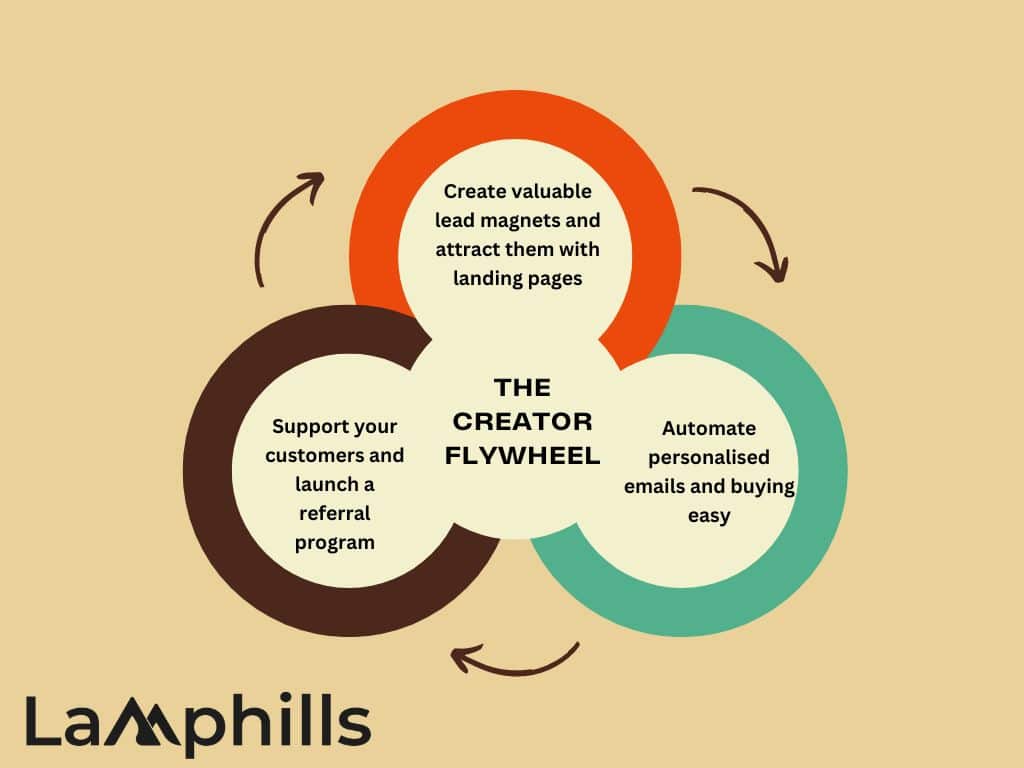I’ve talked to many business owners, and there’s one strategy they all babble about flywheel marketing. Unlike the traditional sales funnel, flywheel marketing uses the power of your customers to drive sales. Let me share a story from my time working at a coffee shop to illustrate how this works.
Some months back, I joined a coffee shop with a simple yet profound vision: to create a place where every customer felt like family, and the aroma of freshly brewed coffee could draw people in, fostering lasting connections.
We decided to implement the flywheel marketing strategy, starting with attracting customers. We launched a blog and social media pages, sharing heartfelt stories about our journey. We hosted events, including free coffee-tasting sessions, that attracted coffee enthusiasts from all over town. One memorable day, a local food blogger attended one of our events and wrote a glowing review, bringing in a wave of new customers.
But attracting customers was just the first step. We needed to keep them engaged. So, we introduced a loyalty program and a monthly newsletter filled with coffee-making tips. Engagement alone wasn’t enough; we had to delight our customers. We made an effort to remember their names, favourite orders, and special occasions. Imagine walking into a place where everyone knows your name and your regular order. We even took the extra step of calling some of our customers to wish them a happy birthday.
By attracting, engaging, and delighting our customers, we gave them reasons to refer others to us and keep coming back. The result? A thriving coffee shop where our customers felt like family, driving our growth through their loyalty and enthusiasm. This is basically what flywheel marketing is all about. Do you want to try out this in your business? Then read through the article.
What Is a Marketing Flywheel?
Flywheel is a marketing strategy that keeps your customer at the centre of your marketing efforts. Your customers then become the momentum or mechanical energy that drives your business forward. It places your customers in the centre and delights your audience from the first interaction, turning them into first-time buyers, repeat customers, and loyal customers. The key to a flywheel marketing strategy is momentum.
Instead of focusing on attracting as many new readers or viewers as possible and ignoring them once they buy from you, the flywheel Marketing strategy nurtures relationships with people who want to do business with you, delighting and engaging them so they become loyal customers and advocates for your business and contents.
Key Points
- The marketing flywheel shifts focus from traditional customer acquisition to nurturing relationships with existing customers. By delighting customers at every stage of their journey, businesses can transform them into loyal advocates who contribute to sustainable growth.
- The flywheel model emphasizes three key stages: attraction, engagement, and delight. Attraction involves creating compelling content to draw potential customers, while engagement focuses on nurturing leads and building trust. Delight aims to exceed customer expectations by fostering loyalty and encouraging referrals.
- Friction points such as poor customer service or complicated purchasing processes can slow down the flywheel. Businesses should proactively identify and address these issues to maintain momentum and ensure a seamless customer experience.
- Unlike the linear funnel approach, which focuses on acquiring new customers, the flywheel model leverages existing customers as advocates to drive growth. This approach emphasizes ongoing engagement and customer success, resulting in higher retention rates and sustained business growth.
How Customers Impact Your Marketing Flywheel
Instead of seeing customers as conversions, marketing flywheel empowers marketers to view customers as assets and keep customers involved in growing the brands. The marketing flywheel isn’t targeting mostly customer acquisition, just like the traditional sales funnel; it’s key target or focus is to use customers to drive expansion. They make customers the critical part of the marketing strategy. Employing the flywheel concept, the momentum of your satisfied customers is utilised to stimulate referrals and recurring sales. In essence, your business maintains its momentum. When you envision your business as a flywheel, it influences your decision-making and strategy adjustments.
The marketing model enables marketers to see customers as valuable assets, actively engaging them in brand growth processes, unlike traditional sales funnels that aim mainly at customer acquisition. If your customers experience poor customer service or hiccups in their buying journey, this can cause friction in the flywheel. Customer inconveniences, such as long wait times or disappointments with final product delivery, can cause frustration. Friction, as a negative force, always reduces the momentum of your flywheel and hinders business growth.
However, following a flywheel marketing model allows you to monitor drops in momentum and identify areas of friction. From there, you can take the necessary actions to:
- Create an easy customer experience
- Develop a plan to reduce friction as much as possible
- Determine why customer inconveniences are occurring.
Flywheel Marketing Model in Action
To ensure an exceptional customer journey with your brand, you can effortlessly integrate the three-phased inbound marketing methodology into each stage of your flywheel model. Let me give a detailed explanation of the marketing flywheel model
#1. Attraction Stage
As a marketer, your first step is to create educational, attractive or innovative content that will draw people to your page. When these visitors engage with your content, they learn more about your brand. The type of creation depends on what you think will resonate with your target audience. You can also develop content marketing materials like ebooks offering a deep dive into complex subjects showcasing your expertise, videos, blog posts that provide valuable insights into topics relevant to your audience, tutorials and videos that provide visual, easy-to-understand instructions, and social media campaigns that promote interactive communication and brand visibility to attract customers. You can also create Web articles and pay-per-click (PPC) ads. This is where the power of digital marketing and social media marketing becomes evident, drawing in modern customers through engaging online content.
#2. Engagement Stage
You are done attracting your customers; it is now time to form a relationship with them. Your content marketing strategy should involve segmenting visitors based on common characteristics if you want to drive sales. You need to engage and nurture your leads to Foster trust and convert them into customers. For this section of the Flywheel, you need to focus on strategies like email marketing and conversion rate optimisation (CRO). This phase should not be seen as just a conversion point where leads are turned into sales. Instead, consider it an opportunity to meaningfully engage with your visitors, aiming to sustain a long-term relationship. The momentum from these relationships will play a key role in improving your business growth.
Before we proceed, this is a detailed FREE template that will further guide your path while implementing the flywheel marketing model in your business:
Flywheel Marketing. Template
#3. Delight Stage
This stage is all about your customers’ success. Your objective is to do whatever you can to empower your customers to reach their goals. This stage can also be called the satisfaction stage. Your objective here is to provide maximum support to enable your customers to reach their goals. You will need to invest in tactics like omnichannel, customer service, loyalty programs, and other customer retention strategies. You may be able to delight your customers by:
- Designing an automatic or more streamlined onboarding process can help users understand and use your products and services effectively.
- Distributing post-purchase customer feedback surveys to gain insights into their experiences and identify areas of improvement.
- Creating a loyalty program
- Adding self-service customer service chatbots to your website to offer instant assistance and answers to common queries, promoting a self-service culture
- Making UX design changes to your website based on their feedback to enhance ease of use and satisfaction
- Creating a community using your current customers and prospects, thereby encouraging repeat business and deepening customer relationships.
How to Set up a Flywheel Marketing Model
To make the switch from a traditional sales funnel to flywheel marketing, you will need to create unified processes that allow you to efficiently track customers’ touchpoints. Remember that what powers your flywheel is the customer’s experience. Therefore, all of your marketing efforts must centre around creating easy buying processes and building positive interactions with your brand.
There are some digital marketing software or tools that can help you track your customers, identify inconveniences, and gather feedback about their experience. These tools includes:
#1. Sales Customer Relationship Management Systems (CRMs)
It plays a vital role in managing the relationships and interactions your business has with your customers and potential leads. They can help you centralise your customer’s information and record all interactions between the customer and the company. This collection will provide valuable insights about your customer’s Behaviors, pain points, and preferences enabling you to create personalised marketing campaigns and improve customer service. A well-implemented CRM can enhance customer retention and drive sales growth. Examples are Hubspot and sales forces.
#2. Marketing Automation Software
Marketing automation software is software designed to streamline and automate marketing tasks, making them more efficient and effective. For email marketing campaigns to social media posts, marketing automation applications can manage repetitive tasks across multiple channels. This allows marketers to focus on strategy and creative work rather than on the technical aspects of implementation. These tools are very good at nurturing leads with personalised content based on their interests and interactions with your brand, leading to a better conversion rate. Examples include Hubspot”s Marketing Hub and Ominisend.
#3. Content Management System Platforms
A CMS platform enables the creation, management, and modification of digital content, often without the need for specialized technical knowledge. With a CMS, marketers can quickly update website content, add new blogs or products and create landing pages for campaigns. CMS tools also facilitate SEO optimisation, content scheduling, and integration with other marketing tools, which helps to enhance the visibility of your brand and attract more visitors to your website. Examples include WordPress and Drupal.
#4. Customer Feedback Tools and Review Generator
These tools offer an effective way to gather and manage customer reviews, both positive and negative. They provide a platform for customers to voice their experiences, which can give you insights into what’s working well and what areas need improvement. Additionally, they can help build trust with potential customers, as many people rely on reviews when making purchase decisions. By actively seeking feedback, you not only show customers that their opinion matters but also get valuable information that can be used to improve customer experience, ultimately boosting customer satisfaction and loyalty.
You also have to keep these flywheel Marketing best practices in mind when developing a flywheel marketing model:
- Understand the 3 core focus areas of inbound marketing and use them to drive customers through the buying cycle.
- Set up metrics such as cost per acquisition, retention rate and email signups for each stage
- Monitor customer’s touchpoints for friction and take immediate actions to rectify complaints
- Evaluate your results and look for ways to make continuous improvement to the cycle.
Why Should You Use Flywheel Marketing?
There are several roles flywheel Marketing plays in the business. A few of these benefits include:
#1. It Helps You Earn More Qualified Leads
With the customer at the centre of focus, every action taken focuses on delivering the best experience for them and this will make them refer your business to others. When leads think about purchasing a product or service, they often inform their families and friends of the experience they had with your company. This, in turn, increases the number of verified leads for your business. Recommendations are among the most powerful growth mechanisms. People who saw your courses, products, ebooks, and coaching and enjoyed the process will gladly tell their families and friends about it. The more you delight them, the more you make them happy.
#2. It Helps to Build Interaction With the Entire Team at Once
This is one of the significant drawbacks of the funnel because people interact with different entities in your company at different stages. That is, they will interact with sales representatives at one stage, cashiers at another stage, and customer service agents at the next stage. This can cause a confusing experience. But with the marketing flywheel, you interact with all members of the team at every part of the cycle. By unifying your teams, you reduce friction and confusing experiences that can create blockage for your customers and keep flywheels from turning. Instead, you create a more cohesive experience that pushes people through the cycle.
#3. It Helps You Maintain Your Loyal Customers
Retaining loyal customers actually costs less than trying to bring in new ones every single time. If you think about it, these prospects have already shown interest in your business by purchasing your products. Unlike the traditional sales funnel, which doesn’t account for mailing small customers, the marketing flywheel aims to maintain current customers while trying to earn new ones. This process leads to higher customer retention, increasing your return on investment (ROI) for your marketing strategies. It gives you a lunch-ready audience because they already know that your paid content is worth their time and money. Building a new audience when launching is helpful but a marketing flywheel model ensures that your current customers are happy to buy from you again.
Marketing Flywheel vs Funnel: The Differences
The marketing flywheel aims to build long-lasting relationships with customers, turning them into loyal buyers and brand ambassadors but the funnel is linear. Funnel just aims to add people to the funnel, nurture them through the middle, and then convert them into customers at the bottom and that’s the end. When comparing a funnel to a marketing flywheel, there are things to keep in mind and they include:
- Flywheel marketing leans on your existing base of customers and subscribers, while funnel marketing requires you to constantly create content from scratch to reach new audiences.
- With Flywheel, you benefit from the combined reach of your subscribers and customers, while with Funnel, much of your success hinges on your own social media reach and algorithms.
- Flywheel fuels your revenue with the audience you have attracted and nurtured.
- In the flywheel, customers are seen as an input, whereas in the funnel, customers are seen as an output.
- Flywheel recognizes ongoing customer loyalty and engagement, while funnel represents a constant start-stop rhythm every quarter
- Flywheel focuses on customers’ success, while the funnel emphasises widening awareness.
The marketing flywheel concept, although relatively low, is being adopted by many companies. To shift from a funnel to a flywheel model, you need to organise your metrics and put more emphasis on delighting customers.
How the Marketing Flywheel Works for Creators
Flywheels are seen as growth loops that feed on themselves to create results in the creator’s economy. Instead of focusing on creating content that attracts new people into your online world, you infuse value into every customer’s touchpoint. This works in everything you are doing, whether it is personal finances, conscious parenting, or even bullet journalism. It pays off whatever your goal, from running online courses and selling worksheets to offering group coaching and running events.

A flywheel is just like a pinwheel and requires force to spin. There are two opposing elements that can make this work. These include:
- Forces
The strategies that speed up the customer flywheel, create a better customer experience and turn casual readers into loyal customers. For example, great customer service, easy payment methods, offering a product that matches the customer’s goals, and a comforting refund policy.
- Friction
This slows your flywheel by making the customer work harder to purchase from you or gain value from your products. For example, payment issues, poor customer service, and a no-refund policy.
Your goal is to increase force and decrease friction as much as you can and one of the best ways to make it happen is through email marketing.
What Is a Flywheel Strategy?
Flywheel strategy happens when small wins for your business build on each other’s time and eventually gain so much momentum that growth almost seems to happen by itself.
What Is the Purpose of Flywheel in Business?
A flywheel effect in business is a cycle when businesses create a positive customer experience, leading to increased sales and customer loyalty. This cycle can be achieved through excellent customer service, high-quality products, and effective marketing and advertising technologies.
What Is a Flywheel in Commerce?
E-commerce businesses are consistently looking for ways to drive growth and profitability. One increasingly popular framework is the e-commerce flywheel, which provides a model for continuous improvement and scaling.
Conclusion
The Flywheel Model may very well be the most important model modern businesses can adopt, as it puts customers at the centre of each business operation that moves the company forward. While it may take some time and shifts, the process is worth it if you can enjoy constant growth that’s driven by consumers and raving fans.
Related Articles
- Integrated Marketing Communication: 5-Step Guide for Integrating Marketing Communication Across Channels
- How to Write a Marketing Email: A Step-by-Step Guide for 2024
- Brand Marketing vs. Content Marketing: How They Differ and Work Together
- 15 Free Digital Marketing Resources and Tools I Recommend in 2024






